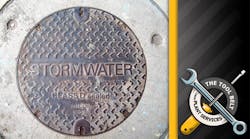Podcast: Why facilities need more and better stormwater data to improve disaster preparedness
Zorana Kojic is a regional sales executive for StormSensor, a company that links critical storm, sewer, and coastal infrastructure performance to climate data. StormSensor’s goal is to provide real-time advanced insights on flood and overflow risks across the community, including factories. The company offers advance insights and warnings when there might be a disaster or stormwater event that could impact plant operations. Plant Services editor in chief Thomas Wilk and managing editor Anna Townshend recently spoke with Zorana about how this new technology can help plants make better decisions about disaster preparedness to avoid unplanned downtime.
PS: Zorana, your session at ARC was really interesting because it detailed technologies which facilitate more efficient plant operations, sometimes laterally, sometimes directly. Tell our readers, who are mostly in the maintenance and reliability space, tell us a bit about yourself and the path that led you up to working for StormSensor.
ZK: Sure. So my background was actually in biological engineering. I went to the University of Florida and I worked as an undergraduate researcher in environmental engineering, and decided to go that way. One of my first jobs actually included many interactions with industrial maintenance and operations. I was an Industrial Pretreatment Technician with my city's public works. As plants were industrial contributors of wastewater, I helped maintenance, EHS (environmental health and safety) personnel understand their permits and often we would have to work together to solve problems to keep them working but also staying within their allowable discharge limits.
Following that I stayed in the wastewater treatment industry, designing different systems for treatment manufacturers or as a consultant. Lastly I got into flow instrumentation. When I saw what StormSensor was doing, I thought "Wow! This is the next level up" because a lot of instrumentation is still wired for local output only. So when it comes to exporting data, someone still has to go to the controller with a flash drive, download the data, upload it into their laptop back at the office and then they still only have an Excel file (if the file did not get corrupted). Now they get to analyze the data. Nowadays that is not fast enough. StormSensor lets you see the data in real-time.
PS: That's really cool. Anna and I have a lot of questions about how the technology works, where the data is stored, so let me ask the first question about that. There's language on the website which says that stormwater is the last unmetered utility and I really appreciate that, where before companies like StormSensor came along, this was a by and large unmetered unsensored aspect of infrastructure. And I'm curious to know, let's talk first about where the sensors are currently placed because it was a challenge for the company to develop a sensor that would actually operate reliably in this unique environment – kind of slimy, sludgy stormwater, right?
ZK: So we actually have two types of sensors. Both are ultrasonic. One is a depth sensor mounted at the top of an outfall, vault or large pipe and it measures depth. The other provides velocity and temperature data and is mounted inside a pipe.
By combining the sensor data with weather data we are able to combine it all in an easy to understand cloud-based dashboard that gives the customer actionable insights. They're able to make an informed decision on how to best address problems like capacity or drainage issues that if left unaddressed can create flooding conditions. The insights also allow customers to be strategic about their maintenance too. For a simple example, one of our customers in Florida had a palm frond make it into their stormwater inlet where we have a sensor installed. Our sensor showed that this area was constantly full. We knew this was not true due to the weather data. Thus, our data insights notified the customer and they were able to send maintenance to remove the obstructing palm frond that could have caused that inlet to back up. They did not need to waste time and money having maintenance staff drive around looking into each inlet to clean it out. They knew when and where to go when as soon as it happened. Very simple things, but our data was able to give them that insight in real-time.
PS: Very interesting. I'd love to hear about some of the real life examples that you have and you have some great case studies to talk about. But first I want to touch on one aspect of the technology in terms of data storage and collection. You talked about the need for the immediacy of that data and getting that to the end user as quickly as possible. So can you talk about how that data is stored? Is it in the cloud? Is it on-prem? Is it a combination?
ZK: All of our data is stored on the cloud. There are two ways the data can get there. One is through a wireless telemetry system called the LoRa network and the other is cellular. In the case of the LoRa network, the sensors send their information to a telemetry box and then the telemetry box sends the info to a gateway via LoRa. Then the gateway uploads the data to the cloud. This is great if it’s a more remote area and/or if it’s a small area to be studied, say a neighborhood or for the case of our readers, an industrial plant. The other option is to communicate the data via a cellular network. This is very dependable in urban environments. So depending on what the customer needs, we can transmit the data in real-time from sensor to cloud.
We are also able to take that service up another level. So besides data, what else can a customer obtain? For example, if they were mostly interested in depth at a specific location, we can set a critical depth alert that sends out a text message. They can then respond by turning on a pump or anything like that. They have the time to make a decision to protect their assets because they received the alert.
PS: I was really surprised to find out that most municipalities really don't know what those levels are, and it's sort of a guess that they're doing in terms of some calculations. To actually get those numbers is really interesting.
ZK: Yes from a regulation standpoint, only 42 states declare stormwater to be a utility, the way electricity, drinking water and wastewater are. For example, Louisiana just came out with new legislation this past winter that allows stormwater infrastructure in the state to be declared a utility system. Because of that legislation, communities are able to create a fee and thus fund the maintenance and improvement of their aging infrastructure. Most stormwater systems were designed and installed decades, if not a century ago in some places, a time with less people, less impermeable surfaces and different climactic conditions.


